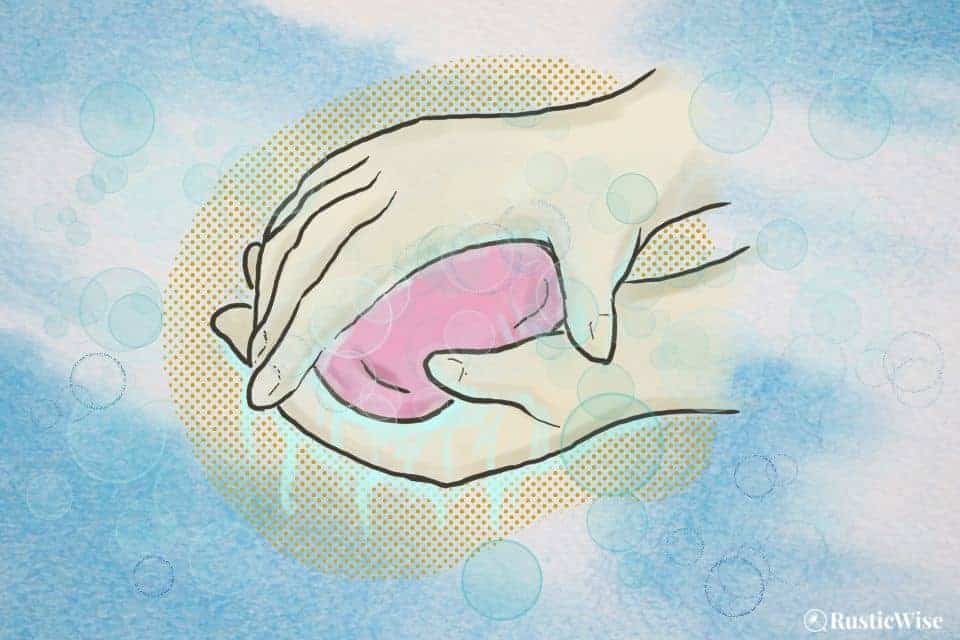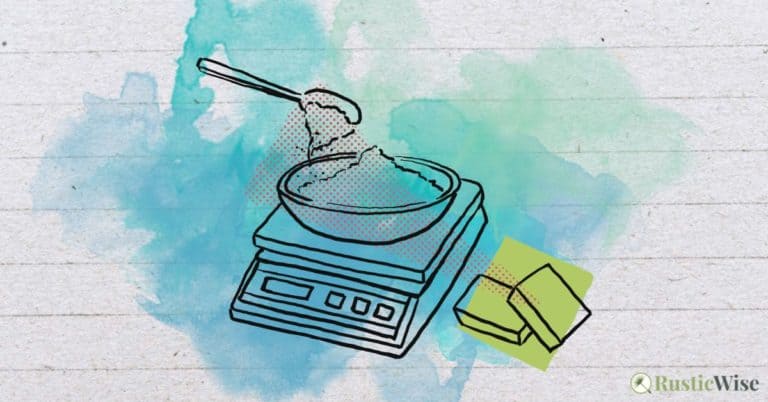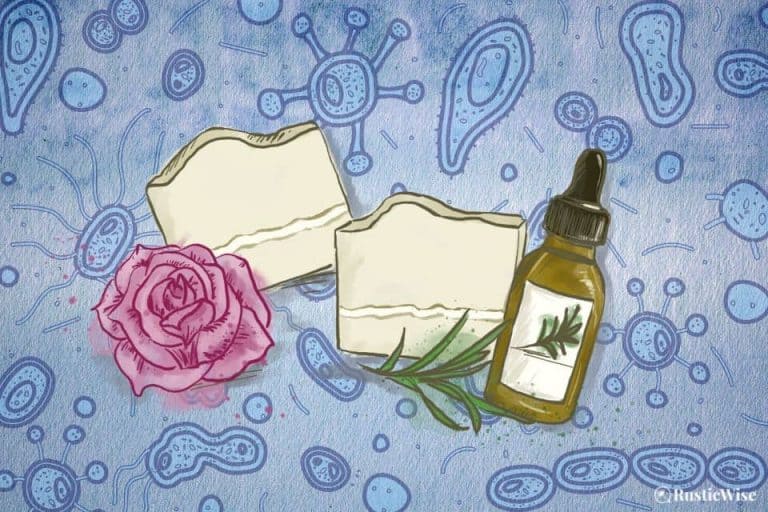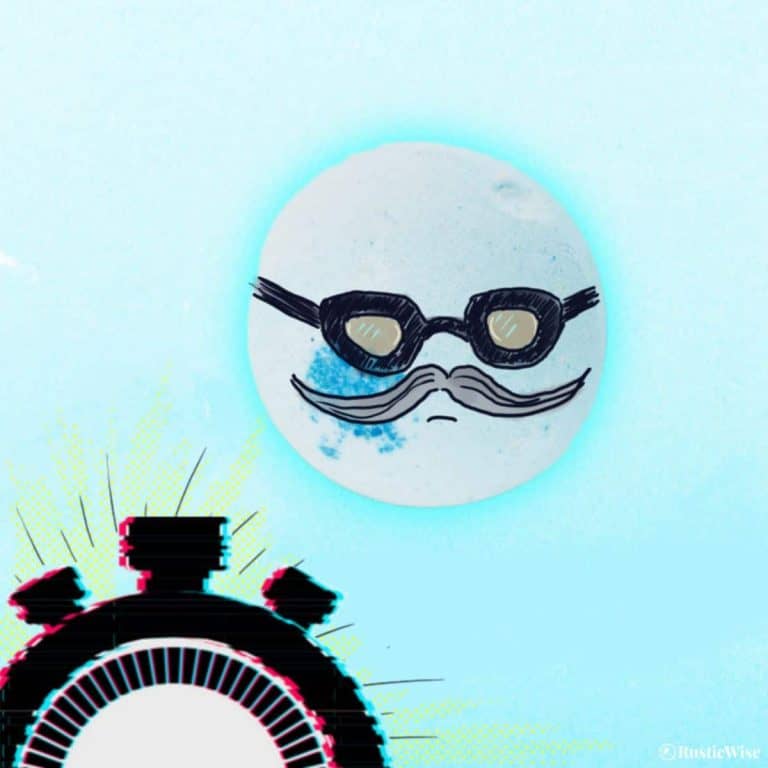Sodium Lauryl Sulfate vs. Sodium Laureth Sulfate (SLS vs. SLES)
If you’ve ever checked out the ingredients list on your dish soap or shampoo, you’ve probably heard of the terms sodium lauryl sulfate (SLS) and sodium laureth sulfate (SLES).
Let’s go over key differences and similarities between sodium lauryl sulfate vs. sodium laureth sulfate. Both are synthetic surfactants used for cleaning and boosting lather, but SLES is milder on skin.
While commonly found in a wide range of household products, from cosmetic products and toothpaste to liquid soap, you might want to rethink using products with these two ingredients if you have sensitive skin. (Both are linked to skin irritation.)
Whether you have health concerns or are just looking for products with more natural ingredients, we’ll go over everything you need to know about SLS and SLES. Do these chemicals deserve their bad reputation? Keep reading to find out!
What are SLS and SLES, exactly?
Sodium lauryl sulfate (SLS) and sodium laureth sulfate (SLES) are both anionic surfactants and detergents that you can find in many personal care products and cleaning products.
Surfactants lower the surface tension of water which allows oil and dirt particles to more easily wash away. In a cleaning products such as dish detergent, surfactants remove grease from dishes; in shampoos, surfactants remove built up grease in hair.
Both SLS and SLES create foam and lather to create the desired texture most of us expect in cleaning and skincare products.
The main difference between SLS and SLES is that the latter goes through an extra step during manufacturing called ethoxylation that is meant to make it gentler on skin.
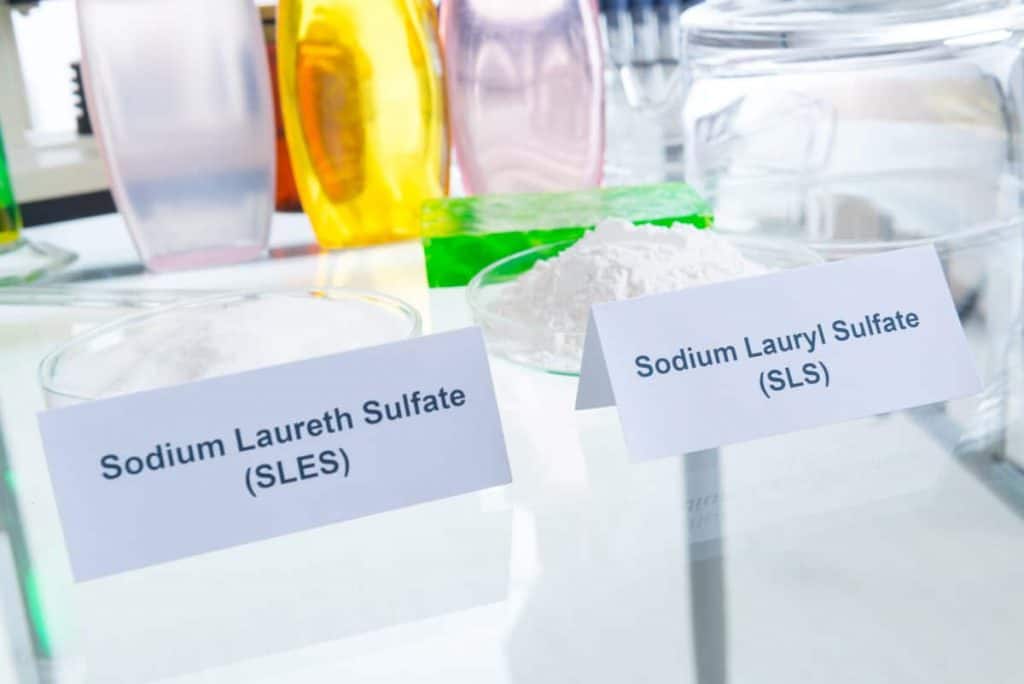
A closer look at sodium lauryl sulfate vs. sodium laureth sulfate
In the chemical world, sodium lauryl sulfate (SLS) and sodium laureth sulfate (SLES) are like two close relatives from the same family tree.
Both are anionic surfactants (compounds that reduce surface tension of water and allow oil and dirt to wash away more easily). However, SLS is considered a harsh chemical, while SLES has undergone an extra processing step to make it milder for skin. (This extra step has consequences, as we’ll explain further below.)
First, let’s clear up the synonyms. SLS goes by many other names, including:
- Sodium dodecyl sulfate (SDS)
- Sodium laurilsulfate
- Monododecyl ester sodium salt sulfuric acid
- Sodium salt sulfuric acid
- Monododecyl ester
Here are a few other names SLES goes by:¹
- Sodium lauryl ether sulfate (sodium “laureth” is short for “lauryl ether”)
- Sodium 2-(dodecyloxy) ethyl sulphate
- Dodecyl sodium ethoxysulfate
Now let’s look at the molecular formula of each.¹
First, sodium lauryl sulfate is the sodium salt of lauryl sulfate. SLS has the following formula: C₁₂H₂₅NaO₄S.
Sodium laureth sulfate is the sodium salt of a sulfonate ester. SLES has the following formula: C₁₄H₂₉NaO₅S.
(There’s also another chemical with a similar name, sodium laurate, which differs from both SLS and SLES. Sodium laurate is the sodium salt of lauric acid.)
How are SLS and SLES made?
SLES derives from SLS, but undergoes an additional manufacturing step. So first we’ll look at how producers make SLS.
Manufacturers can derive SLS from plant-based products, such as palm oil or coconut oil; or synthetically via petroleum-based products.
They create SLS via synthesis of lauryl alcohol together with sulfur trioxide. This creates hydrogen lauryl sulfate which is neutralized with sodium carbonate (aka washing soda) to finally make SLS.²
Now to convert SLS into SLES, it must undergo a process called ethoxylation, which is intended to make chemicals gentler on skin. Ethoxylation involves reacting a chemical with ethylene oxide.³
What could go wrong with trying to make chemicals less harsh? Plenty, it seems.
When a chemical reacts with ethylene oxide, it makes a byproduct called 1,4-dioxane.
Ethoxylation is the process of reacting ethylene oxide with other chemicals to make them less harsh. Ethoxylation can create small amounts of 1,4-dioxane and leave residual ethylene oxide in the product.³
This process of ethoxylation introduces the chemical to toxic contaminants (ethylene oxide and 1,4-dioxane) which are carcinogens. This makes SLES a possible health concern.
The takeaway: While SLES is milder and less drying on skin, the result is that it may contain toxic carcinogens as a result of the manufacturing process. You can tell chemicals have undergone ethoxylation by looking on the product label for ingredients ending in “-eth.”
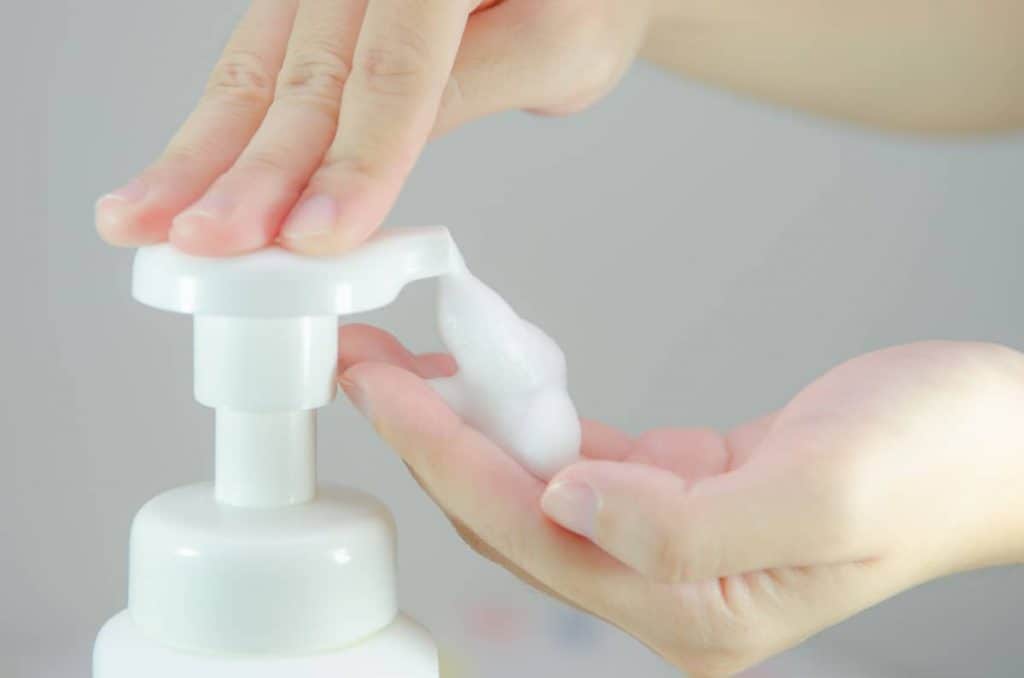
Credit: Yay Images
What products contain SLS and SLES?
As both SLS and SLES are affordable to produce and are effective cleansers which act as foaming agents, you’ll find them in a wide range of household products.⁴
Household cleaning products are essentially synthetic detergents that work to strip surfaces of fat, oil, and grease to remove oily stains. SLS and SLES boost cleaning action. Pick up a common cleaning product and you’ll like see SLS and SLES listed as in ingredient.
- Dish soap
- Degreasers
- Laundry detergent
In skincare and body care products, SLS and SLES work to build foam and strong lather. And of course they also work to clean. You can find SLS in the following personal care products:
- Toothpaste
- Bath bombs and bubble bath liquids
- Hair care products such as shampoos and conditioners
- Hair dye and bleach
- Body wash or shower gel
- Bath oils and salts
- Foaming facial cleansers
- Shaving cream
- Cosmetics
The U.S. FDA also permits use of small amounts of SLS as a food additive. It works as an emulsifier to thicken foods or to change the texture. You’ll find it used in:
- Marshmallows
- Dried egg products
- Some fruit juices (to mix acids with liquids)
Sodium lauryl sulfate vs. sodium laureth sulfate: key similarities
With such similar names, it’s no surprise that SLS and SLES share many of the same characteristics. Let’s take a closer look.
- Both are anionic surfactants: There’s no denying the cleaning power of both SLS and SLES—they strip away oil and grease. Unfortunately, when it comes to hair and skin, a certain amount of natural oils are beneficial. The strong cleansing properties of these compounds are cause for concern, especially if you have tender skin.
- Both create foam and enhance texture: Those lovely bubbles or foamy lather we expect in consumer products come from these two chemicals. Manufacturers use these ingredients as emulsifiers and thickeners in a wide range of beauty products and industrial applications.
- Both are skin and eye irritants: Getting any kind of soap or shampoo in your eyes is no fun—we know both chemicals are eye irritants. Both SLS and SLES cause skin and eye irritation. Many people experience dry skin or itchy skin, to more severe symptoms such as flare-ups and redness. This results in water loss from the skin barrier. Atopic dermatitis, dandruff, and dry hair are all side effects of sodium lauryl sulfate, or its cousin, SLES, for some when using certain skincare products or hair products.
- Both pose environmental concerns: SLS is toxic to aquatic animals, according to the World Health Organization (WHO). Similarly, 1,4-dioxane is a persistent chemical that doesn’t break down easily. This means it may remain in waterways long after use.⁵
Key differences of SLS vs. SLES
The key differences between SLS and SLES are their harshness (for skin and hair) and related health concerns.
SLS is harsher on skin and hair
SLS is considered a harsher cleaning agent than SLES.
It penetrates the skin barrier, causing more skin barrier disruption. One study shows that SLS can penetrate between 5 and 6 millimeters below the point of topical application.⁶
There are many studies linking SLS usage with various skin conditions. A 2003 study examined 1,600 patients and found that close to 42 percent of people experienced an irritant reaction on skin when using SLS.⁷
And SLS has such a known skin irritation potential that it’s used as a baseline skin irritant for patch tests.
Because of the process of ethoxylation, SLES is a milder surfactant. However, this brings about many chronic health concerns, as we’ll see below.
Common myths about SLS
There are many misconceptions about SLS and its relative, SLES. First, let’s clear the cobwebs and debunk some myths about sodium lauryl sulfate.
A 2015 study finds the following conclusions about SLS:²
- SLS is NOT a carcinogen. To date, there are no strong links to SLS and cancer;
- SLS does NOT cause hair loss. So far, there is little scientific evidence on SLS’s long-term effects on hair follicles;
- SLS does NOT build up in vital organs (brain, heart, or liver) to develop organ toxicity. Some say that SLS is absorbed by the bloodstream, which may develop into organ toxicity. But most SLS remains near the skin’s surface. Any SLS actually absorbed by blood is taken care of by the liver and then excreted by the body; SLS does NOT lead to dermal sensitization (the ability to make skin more allergic or sensitive to repeated applications).
Chronic health concerns with SLES
Now let’s examine sodium laureth sulfate (SLES). We mentioned above how during ethoxylation, SLES is exposed to ethylene oxide and produces 1,4-dioxane.
Both ethylene oxide (a carcinogen) and 1,4-dioxane (a probable carcinogen) pose long-term health concerns.
The U.S. Environmental Protection Agency (EPA) says the following about ethylene oxide:⁸
“The acute (short-term) effects of ethylene oxide in humans consist mainly of central nervous system depression and irritation of the eyes and mucous membranes. Chronic (long-term) exposure to ethylene oxide in humans can cause irritation of the eyes, skin, nose, throat, and lungs, and damage to the brain and nervous system. There also is some evidence linking ethylene oxide exposure to reproductive effects. EPA has concluded that ethylene oxide is carcinogenic to humans by the inhalation route of exposure. Evidence in humans indicates that exposure to ethylene oxide increases the risk of lymphoid cancer and, for females, breast cancer.”
The EPA says the following about 1,4-dioxane:⁹
“Acute (short-term) inhalation exposure to high levels of 1,4-dioxane has caused vertigo, drowsiness, headache, anorexia and irritation of the eyes, nose, throat, and lungs in humans. It may also irritate the skin. Damage to the liver and kidneys has been observed in rats chronically (long-term) exposed in their drinking water. In three epidemiologic studies on workers exposed to 1,4-dioxane, the observed number of cancer cases did not differ from the expected cancer deaths. Tumors have been observed in orally exposed animals. EPA has classified 1,4-dioxane as a Group B2, probable human carcinogen.”
Can manufacturers remove 1,4-dioxane and ethylene oxide from SLES?
While there is a process known as vacuum stripping to remove 1,4-dioxane from SLES, it’s very difficult to know just from reading an ingredients label whether this has been done. There are likely some trace amounts of ethylene oxide remaining in SLES, too.
What about regulations for 1,4-dioxane and ethylene oxide?
In the U.S., the FDA considers 1,4-dioxane and ethylene oxide as byproducts of the manufacturing process and does NOT require them to be listed on product labels.
In Canada, these two substances are banned for use in cosmetics. The European Union has also banned ethylene oxide in cosmetics.³
The takeaway: There’s really no way for consumers to know if any trace amounts of 1,4-dioxane and ethylene oxide remain in the product. Some manufacturers may choose to remove all contaminants, but you may need to do a bit of research into your favorite products.
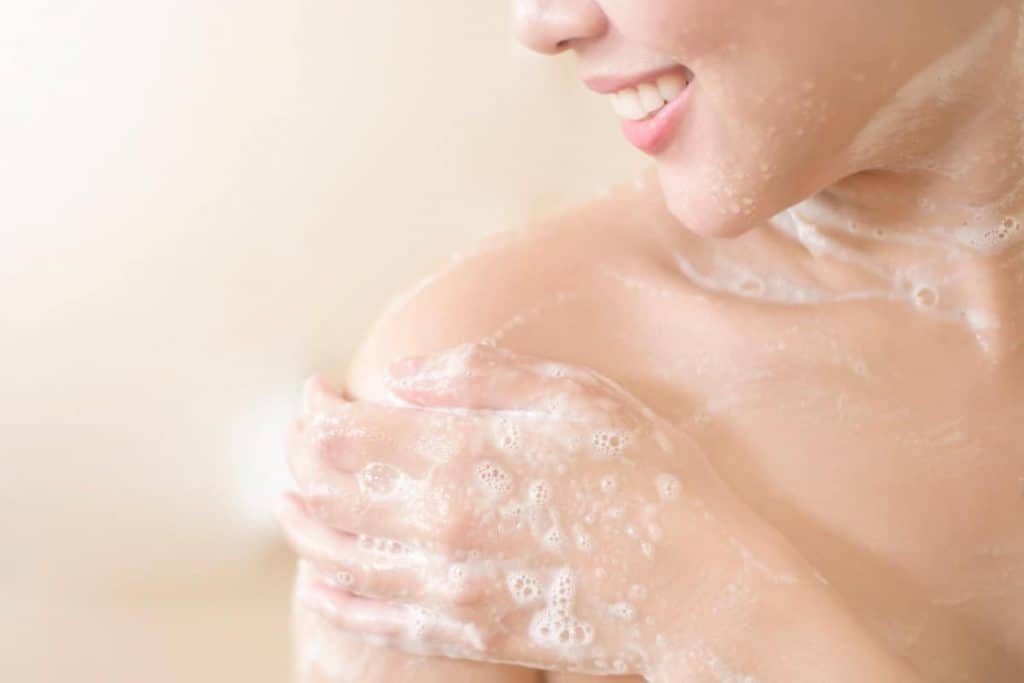
Why avoid SLS and SLES?
If you’ve ever used a cosmetic, lotion, or soap and experienced an adverse side effect, you might want to consider an SLS free product, such as sulfate free shampoo.
Or if you have dry or sensitive skin, or are just looking for more natural ingredients to add to your daily routine, you may wish to avoid products containing SLS and/or SLES.
Be wary of products that carry labels such as “SLS free.” While on the surface it may seem that they’ve removed SLS and/or SLES, the manufacturer may have simply replaced them with another group of chemicals that may cause similar problems for skin and hair.
Tip: SLS is not the only factor that contributes to irritated skin. Artificial fragrances (which may comprise dozens of chemical compounds), and artificial dyes can also lead to itchy, dry skin.
Safer and milder alternatives to sodium lauryl sulfate and sodium laureth sulfate
With more gentle and safer alternatives on the market today, choosing to avoid SLS or SLES is getting (slightly) easier.
Two plant-based ingredients that are milder surfactants are sodium cocoyl isethionate (SCI) and sodium coco sulfate (SCS). These compounds derive from coconut and are biodegradable. Both SCI and SCS create that lovely foaming action while still providing a gentle clean.
Sodium cocoyl isethionate (SCI) noodles are also called “baby lather” (which gives you an idea of how gentle it is on skin.). Sodium coco sulfate (SCS) is slightly stronger than SCI but still milder than traditional SLS.
And don’t forget about handcrafted natural soap. Homemade soap bars made using cold process or hot process methods don’t use SLS or SLES at all. Instead, these natural soap bars derive cleansing and lathering qualities from the vegetable oils or animal fats used.
(Coconut oil is one type of plant oil that brings on strong cleansing power while also creating strong lather.)
The final word on sodium lauryl sulfate vs. sodium laureth sulfate
So, what’s the final word on sodium lauryl sulfate vs sodium laureth sulfate? While these two chemicals share a similar name, there are key similarities and differences. Both SLS and SLES boost cleaning power as strong synthetic surfactants. They work to actively strip away oil, grease, and dirt while also creating lather.
The downside is that both substances are known skin and eye irritants. Sodium lauryl sulfate differs from SLES in that it’s a harsher cleaner.
Despite many misconceptions, SLS is not known to cause cancer.
SLES undergoes a special chemical process called ethoxylation which aims to make it milder for skin. The downside is that this introduces SLES to contaminants: 1,4-dioxane (a probable carcinogen) and ethylene oxide (a known carcinogen).
Related questions
What does sodium laureth sulfate do to your hair?
Sodium laureth sulfate (SLES) is a common ingredient found in many shampoos and hair products. It’s a surfactant, which means it helps to create a lather and remove dirt and oil from the hair. However, it can also strip the hair of its natural oils, leading to dryness and damage. Some people with sensitive skin or scalp may also experience irritation or itching when using products containing SLES. It’s important to note that not everyone will have the same reaction to this ingredient, and the effects on hair may vary depending on your hair type and the amount of product used.
Are sulfate free shampoos really better?
It depends on the ingredients found in the shampoo in question. Some manufacturers simply remove sulfates like SLS and SLES and simply replace them with other similarly harsh ingredients that can strip hair of its natural oils. However, some replace them with gentler and safer ingredients such as cocobetaines which are coconut oil derived ingredients which tend to be easier on hair and scalp.
What is another name for sodium laureth sulfate (SLES)?
SLES goes by several different names. Often sodium laureth sulfate is labelled as sodium lauryl ether sulfate (“laureth” is short for “lauryl ether”). You’ll also see it called sodium 2-(dodecyloxy) ethyl sulphate, or dodecyl sodium ethoxysulfate.
New to making soap? 🧼❓
👉We have a fantastic overview on the whole soapmaking process here: read our Timeless Guide To Soapmaking.
If you would like to see our soapmaking posts organized by topic type, see our Soapmaking Collection.
Would you like more timeless tips via email?
Fun tips to help you live an independent, self-sustaining lifestyle. Opt-out at any time.


References
- PubChem, Sodium laureth sulfate, https://pubchem.ncbi.nlm.nih.gov/compound/Sodium-laureth-sulfate. Accessed April 2023.
- Bondi, C. A., Marks, J. L., Wroblewski, L. B., Raatikainen, H. S., Lenox, S. R., & Gebhardt, K. E. (2015). Human and Environmental Toxicity of Sodium Lauryl Sulfate (SLS): Evidence for Safe Use in Household Cleaning Products. Environmental health insights, 9, 27–32. https://doi.org/10.4137/EHI.S31765
- Safe Cosmetics, Ethoxylated Ingredients, https://www.safecosmetics.org/get-the-facts/chemicals-of-concern/ethoxylated-ingredients/. Accessed April 2023.
- Chemical Safety Facts, Sodium Lauryl Sulfate, https://www.chemicalsafetyfacts.org/sodium-lauryl-sulfate/. Accessed April 2023.
- World Health Organization (WHO), ILO. International Chemical Safety Card for Sodium Lauryl Sulfate (ICSC 0502), https://www.ilo.org/dyn/icsc/showcard.display%3Fp_card_id%3D0502. Accessed April 2023.
- Patil, S., Singh, P., Sarasour, K., & Maibach, H. (1995). Quantification of sodium lauryl sulfate penetration into the skin and underlying tissue after topical application–pharmacological and toxicological implications. Journal of pharmaceutical sciences, 84(10), 1240–1244. https://doi.org/10.1002/jps.2600841018
- Geier, J., Uter, W., Pirker, C., & Frosch, P. J. (2003). Patch testing with the irritant sodium lauryl sulfate (SLS) is useful in interpreting weak reactions to contact allergens as allergic or irritant. Contact Dermatitis, 48(2), 99–107. https://doi.org/10.1034/j.1600-0536.2003.480209.x
- U.S. Environmental Protection Agency (EPA), Ethylene Oxide, https://www.epa.gov/sites/default/files/2016-09/documents/ethylene-oxide.pdf. Accessed April 2023.
- U.S. Environmental Protection Agency (EPA), 1,4-Dioxane (1,4-Diethyleneoxide), https://www.epa.gov/sites/default/files/2016-09/documents/1-4-dioxane.pdf. Accessed April 2023.

Author: Josh Tesolin
Josh is co-founder of RusticWise. When he’s not tinkering in the garden, or fixing something around the house, you can find him working on a vast array of random side projects.

